Gray Water Recycling Directly Through
Hydroponic Systems
Task Question/Justification:
Can water be recycled in an ALS system through direct
incorporation of gray water into the hydroponic system and using plant uptake /
transpiration as a method of producing clean water?
Abstract:
Recycling water used for personal hygiene will be
necessary in a closed, space-based system. Incorporation of human hygiene water
(gray water) into hydroponic plant production systems, and subsequent recovery
of the water transpired by the plants, is one potential means for water
purification and recycling. The use of plants, and the active microbial
community associated with their roots, for water processing would eliminate the
need for physical-chemical treatment or a bioreactor and the concomitant
resupply of physical components, (i.e., filters, etc.). Volunteers showered and
washed clothes with predetermined amounts of soap (igepon) and deionized water
to provide gray water with an approximate soap concentration of 1000 ppm. Gray
water was added daily (1.5 L) to 20 L hydroponic tanks supporting wheat and
soybeans (separate experiments). Tanks contained a) no gray water (control), b)
soapy water additions (igepon and water), c) filtered gray water (0.2 µm filter
to remove bacteria and skin cells), (soybean study only) and d) unprocessed
(raw) gray water. Both the hydroponic solutions and the rhizosphere were sampled
for microbial composition to determine the survival of human-associated
bacteria. The rate of soap degradation was assessed throughout the plant growth
cycle. Plant material was harvested and fresh and dry mass were determined.
Preliminary findings demonstrated that soap degradation rates increased as plant
root mass, and associated rhizosphere microbial activity, increased. Sodium
levels increased in all gray water treatments over time.
Why recycle gray water through hydroponic
systems?
- Approximately 40 m2 growing area is
needed to support human food and oxygen requirements, yet this produces about
4 times the water requirement (based on 25 L/person/day).
- If an investment in plant hydroponic systems is to
be made for even a 25% food production for ALS, total water required could
potentially be recycled through the system with no additional costs of water
purification equipment and the resulting space, energy and materials.
Experimental Objectives:
Evaluate the effects of directly recycling human
hygiene water through recirculating hydroponic systems on
- growth and development of ALS candidate
crops,
- soap degradation,
- the microbial population in the rhizosphere (root
zone),
- sodium increase in both the hydroponic system and
plant tissue,
Experiments to date
(these are preliminary experiments and analyses are
currently being completed):
- wheat (Triticum aestivum L. cv. Apogee) and
potato (Solanum tuberosum L. cv. Norland): 3-11-97 to 6-3-97, 84
days
(but due to mix cropping problems with potato, only wheat data is
shown)
- soybean (Glycine max L. Merr. cv. Hoyt)
6-27-97 to 9-25-97, 90 days
 |
|
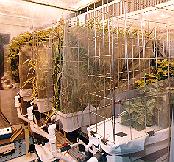 |
Wheat and Potato (day 57) - at left, front two
trays,
control, back two trays, synthetic gray water |
|
Wheat and Potato (day 57) - at left, raw gray
water
(back two trays infected with Pythium fungus) |
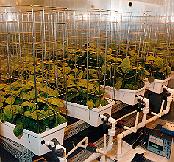 |
|
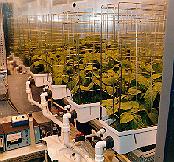 |
Soybean experiment (day 33) - at left, front
two
trays, control, back two trays, synthetic gray water |
|
Soybean experiment (day 33) - back two
trays,
filtered gray water, front two trays, raw gray
water |
Treatments:
- Control - no gray water additions
- Synthetic gray water (Synthetic GW)- soapy water
(no human contact)
- Raw (unprocessed) gray water (Raw GW) - unfiltered
gray water
- Filtered gray water (Filtered GW) - raw gray water
filtered through 0.2 µm filter to remove human-associated bacteria and skin
cells (theoretically this treatment should be identical to synthetic gray
water) (this treatment only used in soybean experiment)
What soap was used?
- whole body shampoo and hand cleaner - used for
both shower and laundry soap
- design specially for the International Space
Station
- from Ecolabs© (Steve Lentsch, 840
Highway 13, St. Paul, MN 55118, (612) 451-5669)
- since 98.7% of product is composed of Igepon TC-42
(sodium N-coconut acid-N-methyl taurate or sodium methyl cocoyl taurate), the
term "igepon’ is commonly used to refer to the soap. It is composed of five
fatty acids (lauric, myristic, palmitic, stearic, oleic)
Gray water production:
- laundry (wheat only) and shower water
- gray water stored at 4 C for up to 2 days
(soybean) or 7 days (wheat)
- both experiments used daily additions of 1.5
L gray water to a 20 L hydroponic system supporting 0.5 m2
growing area
- experiment based on system in which plant
growth provides 25% of food requirement (10m2 /person), but
receives 100% of gray water (25 L /person /day)
|
 |
Plant Growth:
Wheat:
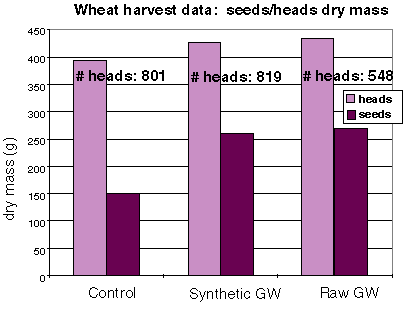
- although all three treatments had similar head dry
mass, number of heads was lower in the raw gray water, indicating larger head
size
- seed dry mass appeared to be greater in the gray
water treatments
Soybean:
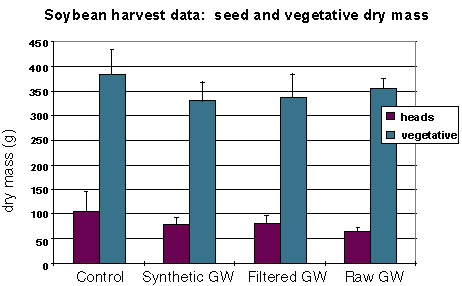
- due to zinc toxicity problem with the control, a
soybean control from a previous experiment in the chamber is shown
- seed and vegetative dry mass data are shown:
results appear slightly less than previous experiment control
- this may not be a direct effect of the gray water,
but an indirect effect caused by pH decline in gray water treatments and
resulting nutrient imbalances
Sodium Accumulation:
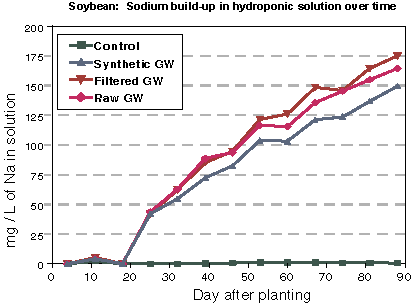
- all gray water treatments sustained an increase in
sodium
- igepon is a sodium-based soap, as are almost all
soaps today
- sodium is not a usual plant element and can be
toxic to plant growth
- as some plants may not uptake sodium, continual
addition of igepon to the system could allow sodium to reach toxic levels
within a year (detrimental levels at ~460 mg L-1 for soybean and
potato, ~1400 mg L-1 for wheat)
- elemental analysis on soybean tissue shows some
incorporation into roots, but minimal into any other section
Soap Degradation:

- The graph represents three time course studies
depicting that the degradation rate of Igepon in raw gray water increases
throughout the growth cycle of soybean. The same trend is found in synthetic
and filtered gray water.
- DAP 10, the first day when soap was added to the
system, soap concentrations remain high 12 hours after addition of gray
water.
- DAP 17, the soap is completely degraded in all
three treatments after 12 hours.
- DAP 73, complete degradation is observed by 6
hours after the addition of gray water.
- Although the initial concentration added to the
tanks was essentially the same throughout the experiment, the decreasing
concentration at time zeros as plants grow is due to the soaps immediate
adherence to the large root mats.
- Soap analysis makes use of the cationic dye
methylene blue, which binds the anionic surfactant Igepon TC-42, then is
extracted into chloroform and intensity of blue color measured.
Microbial Responses:
Soap degraders

- Organisms capable of using soap as a sole carbon
source (i.e., soap degraders) were recovered from all treatments, including
the control. These results indicate that the normal rhizosphere microflora has
a significant potential for soap degradation.
- Numbers of soap degraders increased more rapidly
in the unfiltered gray water treatment, suggesting an inoculum effect.
However, characterization of the isolates showed that the raw gray water
treatment did not contain any unique soap degrading organisms (i.e., of
potential human origin).
- After 83 days, numbers of soap degraders were more
than a log higher in the synthetic and gray water treatments than in the
control.
Total and respiring cell
numbers
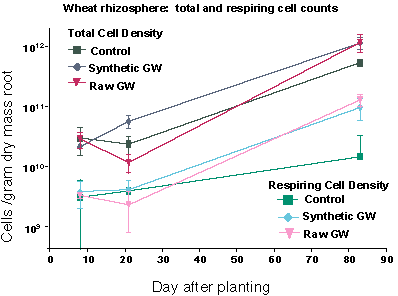
- Total and respiring cell numbers were greater in
both the synthetic and gray water treatments than in the control. This
suggests that soap is a more important source of carbon than the
human-associated component of gray water (i.e., fatty acids, skin cells,
etc.).
Human-associated bacteria
- Current analysis involves evaluation of results
from selective media and molecular studies. Preliminary results suggest that
human-associated organisms do not survive in the hydroponic system.
Conclusions
These are two preliminary gray water studies that
have not yet had a chance to be replicated. From these studies, new experiments
will be designed to better answer the questions that arose from gray water
additions.
- Inclusion of gray water seems to have minor
effects on plant growth, although indirect effects on pH led to additional
problems in the soybean plant system.
- Soap degradation rate increases with time. This is
probably due to increases in root mass and microbial density.
- Soap degraders were recovered from the control as
well as the soap treatments, suggesting that normal rhizosphere microflora has
a significant potential for soap degradation.
- Sodium levels increased in the hydroponic solution
over time from the continual addition of soap:
- these levels could eventually reach toxic
concentrations if the plants do not uptake the sodium
- tissue analysis shows little incorporation of
sodium into soybean tissue
- the sodium question (whether from soap or urine)
is being studied separately.
- use of a potassium-based soap would prevent the
potentially toxic build-up of sodium (potassium is a plant nutrient)
- Need to fully develop molecular methods for
monitoring survival of human-associated bacteria
- Although soap appears to be rapidly degraded
within the hydroponic system, preprocessing though a bioreactor will be
studied as part of solid waste recycling
Author: Colleen Loader cloader@IslandNet.com and Cheryl
Mackowiak /Previously Dynamac International,
Inc., Jay Garland, Lanfang
Levine, Kim
Cook, and Hollie
Vivenzio /Dynamac International, Inc.
A service
provided by the Biomedical Office, NASA/Kennedy Space Center: Dr. William Knott,
Chief Scientist, Biological Programs. 













